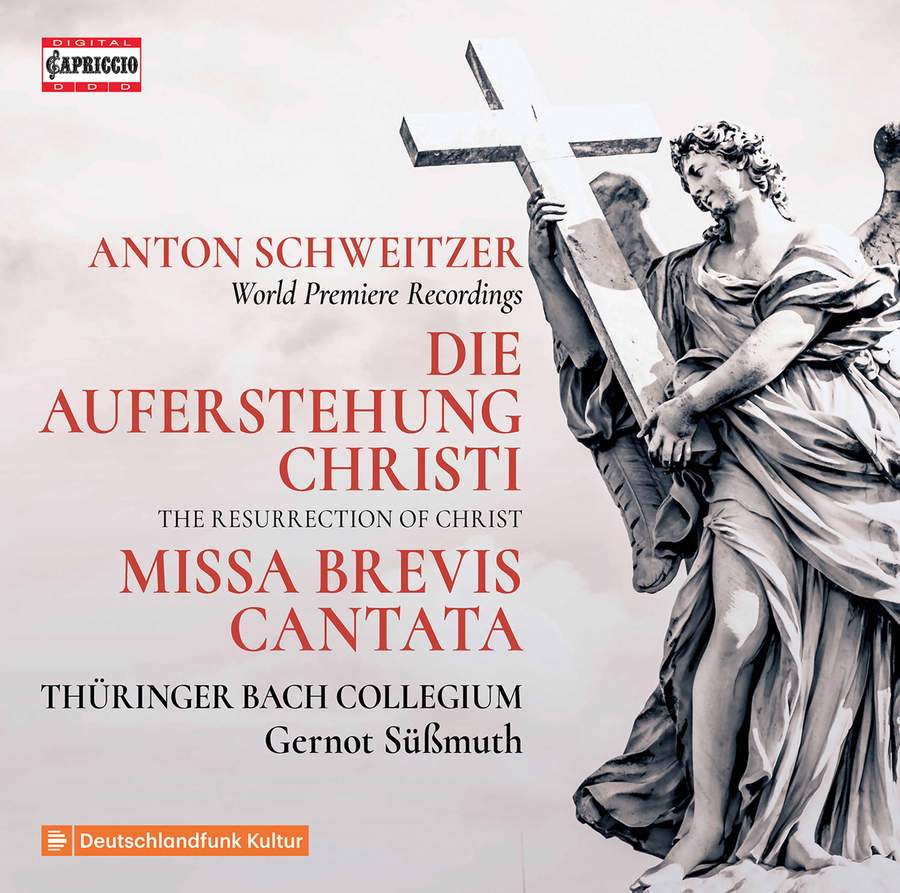SCHWEITZER Die Auferstehung Christi. Missa Brevis Cantata
View record and artist detailsRecord and Artist Details
Genre:
Vocal
Label: Capriccio
Magazine Review Date: 06/2021
Media Format: CD or Download
Media Runtime: 99
Mastering:
DDD
Catalogue Number: C5425

Tracks:
| Composition | Artist Credit |
|---|---|
| Die Auferstehung Christi |
Anton Schweitzer, Composer
Gernot Süssmuth, Conductor Henriette Godde, Mezzo soprano Mirella Hagen, Soprano Stephan Scherpe, Tenor Thüringer Bach Collegium Tobias Berndt, Bass |
Author: David Threasher
Anton Schweitzer – a few years younger than Haydn and dead a few years before Mozart – was mainly active as an opera composer in his native Thuringia. ‘Herr Kapellmeister Schweitzer is a good, worthy, honest fellow, dry and smooth like our [Michael] Haydn, but better-spoken’, wrote Mozart from Mannheim, where he witnessed Schweitzer’s greatest success, the serious opera Alceste. Subsequent works such as Rosamunde, however, failed to elicit respect from the Salzburger. ‘Wolfgang does not like it at all,’ wrote his mother. ‘He says there is nothing natural about it, that it is all exaggerated and that it is not composed to suit the singers.’ Mozart didn’t pull his punches: ‘As long as he lives he will never learn how to write for the voice.’
So much for his operas. (A recording of Alceste is available on Marco Polo/Naxos.) Schweitzer’s sacred music, though, is virgin territory, to the extent that it is not even discussed in his entry in Grove. The Easter cantata sets a text by his ducal employer in Hildburghausen, about 200km south-west of Leipzig. In its sequence of chorus, aria, recitative and chorale it resembles the weekly music of Bach, while its musical language sits somewhere between that and the motets Mozart was composing for the cathedral in Salzburg. If it doesn’t have the enfolding polyphonic richness of the former or the effortless melody of the latter, it’s certainly far more than a merely competent effort. Orchestral effects such as high trumpets in the outer choruses or keening obbligato bassoons in the tenor aria ‘O Heiland, lass’ mich nicht’ lend character but Schweitzer’s dramatic experience comes to the fore in the long accompanied recitatives. Small forces – the four soloists joined by a single-voice SATB chorus – lend intimacy to what must have been a fairly major public work.
A Thanksgiving cantata consists of a large pastoral bass aria with a pithy choral prologue and epilogue, while the Mass is set, like Bach’s missae breves, in Lutheran style – the Kyrie and Gloria only in a series of short movements. Nourishing fare for those curious as to the sort of musical activity that took place between the times and places of Bach and Mozart. The texts of the two cantatas are printed in German only, that of the Mass not at all.
Discover the world's largest classical music catalogue with Presto Music.

Gramophone Digital Club
- Digital Edition
- Digital Archive
- Reviews Database
- Full website access
From £8.75 / month
Subscribe
Gramophone Full Club
- Print Edition
- Digital Edition
- Digital Archive
- Reviews Database
- Full website access
From £11.00 / month
Subscribe
If you are a library, university or other organisation that would be interested in an institutional subscription to Gramophone please click here for further information.




